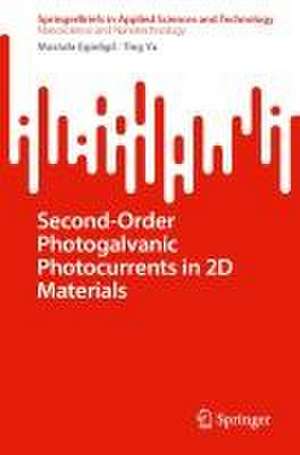Second-Order Photogalvanic Photocurrents in 2D Materials: SpringerBriefs in Applied Sciences and Technology
Autor Mustafa Eginligil, Ting Yuen Limba Engleză Paperback – 17 mar 2024
Din seria SpringerBriefs in Applied Sciences and Technology
-
 Preț: 380.29 lei
Preț: 380.29 lei - 17%
 Preț: 360.33 lei
Preț: 360.33 lei - 20%
 Preț: 386.11 lei
Preț: 386.11 lei -
 Preț: 380.07 lei
Preț: 380.07 lei -
 Preț: 377.95 lei
Preț: 377.95 lei -
 Preț: 382.32 lei
Preț: 382.32 lei -
 Preț: 376.59 lei
Preț: 376.59 lei -
 Preț: 379.09 lei
Preț: 379.09 lei -
 Preț: 378.12 lei
Preț: 378.12 lei - 20%
 Preț: 293.83 lei
Preț: 293.83 lei -
 Preț: 344.90 lei
Preț: 344.90 lei -
 Preț: 321.35 lei
Preț: 321.35 lei -
 Preț: 264.79 lei
Preț: 264.79 lei -
 Preț: 344.90 lei
Preț: 344.90 lei -
 Preț: 356.45 lei
Preț: 356.45 lei -
 Preț: 382.95 lei
Preț: 382.95 lei -
 Preț: 355.65 lei
Preț: 355.65 lei -
 Preț: 479.67 lei
Preț: 479.67 lei -
 Preț: 415.18 lei
Preț: 415.18 lei -
 Preț: 444.52 lei
Preț: 444.52 lei - 20%
 Preț: 301.85 lei
Preț: 301.85 lei -
 Preț: 409.43 lei
Preț: 409.43 lei - 20%
 Preț: 322.17 lei
Preț: 322.17 lei -
 Preț: 355.48 lei
Preț: 355.48 lei - 15%
 Preț: 462.51 lei
Preț: 462.51 lei -
 Preț: 377.18 lei
Preț: 377.18 lei -
 Preț: 355.92 lei
Preț: 355.92 lei -
 Preț: 382.95 lei
Preț: 382.95 lei -
 Preț: 378.12 lei
Preț: 378.12 lei -
 Preț: 378.12 lei
Preț: 378.12 lei -
 Preț: 380.07 lei
Preț: 380.07 lei -
 Preț: 380.07 lei
Preț: 380.07 lei - 20%
 Preț: 326.28 lei
Preț: 326.28 lei -
 Preț: 312.68 lei
Preț: 312.68 lei -
 Preț: 356.42 lei
Preț: 356.42 lei -
 Preț: 412.30 lei
Preț: 412.30 lei - 20%
 Preț: 225.31 lei
Preț: 225.31 lei -
 Preț: 378.12 lei
Preț: 378.12 lei -
 Preț: 376.59 lei
Preț: 376.59 lei -
 Preț: 195.87 lei
Preț: 195.87 lei -
 Preț: 376.22 lei
Preț: 376.22 lei - 20%
 Preț: 324.64 lei
Preț: 324.64 lei - 20%
 Preț: 288.73 lei
Preț: 288.73 lei -
 Preț: 377.57 lei
Preț: 377.57 lei -
 Preț: 261.91 lei
Preț: 261.91 lei -
 Preț: 381.98 lei
Preț: 381.98 lei -
 Preț: 273.63 lei
Preț: 273.63 lei -
 Preț: 410.85 lei
Preț: 410.85 lei -
 Preț: 379.68 lei
Preț: 379.68 lei -
 Preț: 374.30 lei
Preț: 374.30 lei
Preț: 346.86 lei
Nou
Puncte Express: 520
Preț estimativ în valută:
66.38€ • 68.57$ • 55.24£
66.38€ • 68.57$ • 55.24£
Carte disponibilă
Livrare economică 05-19 martie
Preluare comenzi: 021 569.72.76
Specificații
ISBN-13: 9789819706174
ISBN-10: 9819706173
Pagini: 116
Ilustrații: XVI, 116 p. 52 illus., 45 illus. in color.
Dimensiuni: 155 x 235 mm
Greutate: 0.23 kg
Ediția:2024
Editura: Springer Nature Singapore
Colecția Springer
Seriile SpringerBriefs in Applied Sciences and Technology, Nanoscience and Nanotechnology
Locul publicării:Singapore, Singapore
ISBN-10: 9819706173
Pagini: 116
Ilustrații: XVI, 116 p. 52 illus., 45 illus. in color.
Dimensiuni: 155 x 235 mm
Greutate: 0.23 kg
Ediția:2024
Editura: Springer Nature Singapore
Colecția Springer
Seriile SpringerBriefs in Applied Sciences and Technology, Nanoscience and Nanotechnology
Locul publicării:Singapore, Singapore
Cuprins
1. Introduction to light polarization-dependent photocurrent – phenomenology.- 2. Graphene as the model low-dimensional photogalvanic material.- 3. Light helicity dependent photocurrent in graphene planes .- 4. Influence of spin-valley coupling on photogalvanic photocurrents in layered transition metal dichalcogenides.- 5. Light helicity dependent photocurrent in layered transition metal dichalcogenides
Notă biografică
Mustafa Eginligil, professor in the Institute of Advanced Materials, School of Flexible Electronics (Future Technologies), Nanjing Tech University (NanjingTech) in Nanjing, China, foreign expert of Jiangsu Province, received his PhD in Physics from the State University of New York, University at Buffalo, Buffalo USA in 2010 about magnetic properties of II-VI and III-V magnetically doped semiconductors. Then, he joined National University of Singapore Electrical and Computer Engineering in June 2010, as a postdoctoral researcher where he worked on topological insulators and perovskite materials. In 2012, he moved to Physics and Applied Physics in Nanyang Technological University (NTU) in Singapore as a research fellow, to study magnetic and optoelectronic properties of two-dimensional materials, heterostructures, and topological insulators. He is in NanjingTech since December 2015, as a full professor, where he was selected as one of the recipients of 100 Talent of Jiangsu Province (2016), Six Talent Peak of Jiangsu Province (2017), and Talent Ambassador of NanjingTech (2021). His current research interests are chirality and symmetry in physics and chemistry; 2D materials optoelectronics for memory and sensing applications; and energy harvesting materials and related device applications.Yu Ting, professor of the School of Physics and Technology, Wuhan University, China, chief scientist of the key special project of the National Key R&D Program “Nano Frontier” received a doctorate degree from the National University of Singapore in 2003 and joined Nanyang Technological University in 2005 after his postdoctoral as Singapore Millennium postdoctoral fellow, then was promoted to a full professor (tenured position) at Nanyang Technological University, Singapore in 2017. Dr. YU has received many prestigious awards including Nanyang Excellence Award for Research and Innovation (2008), National Young Scientist Award, National Research Foundation Fellowship Award (2009), Outstanding Young Scientist for the 3rd Inter Academy Panel/World Economic Forum (Summer Davos Forum) ((IAP/WEF, Representative of Singapore, 2010) and Institute of Physics Singapore, Nanotechnology award (2011) et al. His research interests cover fabrication of low dimensional, especially 2D materials and investigation of their optical, optoelectrical and optomagnetic properties for developing novel electronics, optoelectronics and data storage devices. Dr Yu has published more than 300 SCI papers and received over 30,000 nonself-citations. His H-index is 103.
Caracteristici
Highlights light polarization-dependent photocurrents in emerging low-dimensional materials Discusses polarization-dependent photocurrents, specifically, on the second-order photogalvanic effects in 2D materials Includes details about the phenomenology of polarized light irradiation on any material system
